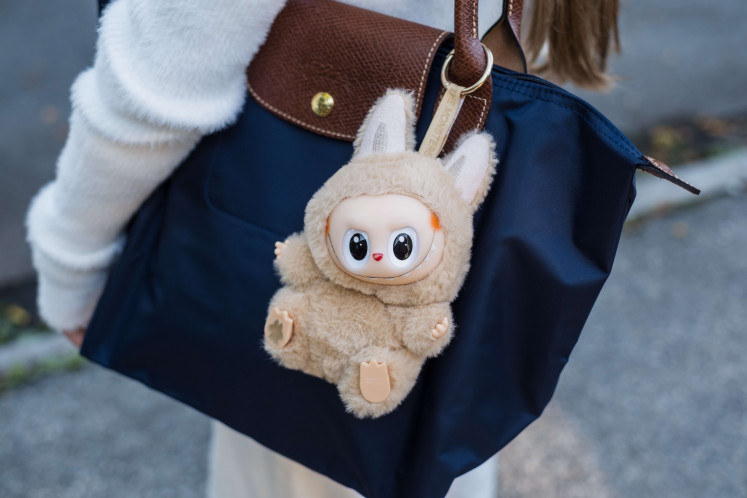Popular Reads
Top Results
Can't find what you're looking for?
View all search resultsPopular Reads
Top Results
Can't find what you're looking for?
View all search resultsAnother masterpiece from singer Ayu Laksmi
A night of music: Singer Ayu Laksmi performs during a concert to mark the launch of her second album at Gedung Kesenian Jakarta playhouse in Central Jakarta
Change text size
Gift Premium Articles
to Anyone
A
em>A night of music: Singer Ayu Laksmi performs during a concert to mark the launch of her second album at Gedung Kesenian Jakarta playhouse in Central Jakarta.
With her trademark meditative and contemporary music style, singer Ayu Laksmi has delivered another work of art with the launch of her second album, Svara Semesta 2.
The new album is the follow- up to her 2010 album Svara Semesta, considered by musicians and critics alike to be one of the most influential Indonesian music albums to date, due to its originality and high artistic quality.
'I never thought I could launch another album after Svara Semesta because I gave my all to that album. I thought I'd put every single part of my music into it,' Ayu said during the new album's launch at the Galeri Indonesia Kaya in Central Jakarta recently.
'However, due to the support of my colleagues and families who were convinced I still had more to give, I will was able to produce the second Svara Semesta album and for this, I thank each and every one of them.'
For Svara Semesta 2, which consists of eight tracks, Ayu uses at least six languages ' Indonesian, English, Balinese, Minang, Latin and classic Javanese ' while touching on humanism, religiousity, spiritualism, cultures, dynamism and equality issues.
In the song 'Btari Nini', she reminds the audience of the ancient tradition of worshipping Dewi Sri, the Javanese goddess of rice.
The ancient tradition stretches from Aceh to West Nusa Tenggara. The song is a reminder of the importance of ethics in using rice as people's main food commodity.
In other songs, like 'Kidung Maria' (Song of Maria) and 'Hyang', Ayu explores the feminine side of spiritualism.
In 'Tri Hita Karana', the singer looks at the harmonization between man, nature and God. In this song, she gives the perspective that the future is a reflection of how we view and respect the process of birth.
Ayu's work on this new album, produced in Bali, is inspired by a traditional ethnic style filled with her innovative vocals.
For the album, she arranged her music by mixing elements from east and west, traditional folklore and modern sounds as well as ancient and modern scripts that are contributed by literati such as Cok Sawitri, Fajar Arcana and Alberthiene Endah.
The album's cover blends traditional and modern elements, featuring a painting from Balinese painter I Made Moja to show the artist's gratitude for and respect toward her Balinese roots and traditions.
An appreciation of her roots can also be seen through her decision to use traditional Balinese scripts within the typography of the album.
During the album launch, Ayu performed some songs from the album, such as 'Duh Ahma', which she said was a song meant for the soul.
She gave only a glimpse of her new work ahead of her concert, titled 'Ayu Laksmi Svara Semesta: Cinta Satu Titik' (Ayu Laksmi Svara Semesta: Love at One Point), which was held on Feb. 21 at Gedung Kesenian Jakarta playhouse in Central Jakarta.
Nevertheless, the preview was more than enough to convince the audience that the second album was another sign of a master at work.
Her music has an hypnotic ambience that takes the mind to a mythical place. It blends ethnic and modern sounds without falling cheaply into just another product, while her husky voice adds another layer to her rich musical sound.
Born in Singaraja, Bali, on Nov. 25, 1967, Ayu started her musical career on a very different path than the one she walks today.
She started her musical journey in 1986 when studying at Bali's Udayana University School of Law. Back then, she was a completely different artist ' a lead vocalist for an all-female rock band in East Java.
In 1989, Ayu grabbed the attention of the country's music scene by filling in on one of the soundtrack songs for the popular Catatan Si Boy 2 teen flick. She began expanding her musical network and was mentored by female bassist and vocalist Titiek Hamzah to establish a group called Trio Cute.
Her musical adventure began to take a different path when she decided in 1997 to take jobs performing on cruise ships heading to the Caribbean. During her voyages on the high seas, she began to rethink her creative process and purpose in music.
After the 2002 Bali bombings, Ayu contemplated her musical direction and decided to take part in the Bali For The World Program 'an effort to heal the region from its wounds.
It was also during this time that Ayu met Balinese scholar Nyoman Sugi Lanus who drew her attention to the rhyme and rhythm of ancient traditional scripts.
Musician Didi AGP, well known for his meditative music, said that throughout her career, Ayu's work had made her more than just another diva.
'Even on Ayu's first album, I saw that she was much more than just a singer. Her voice is not just another sound but it is a representation of the divine,' said Didi, who has known Ayu since her lady rocker days, during the album's launch.
'Ayu has a different energy than other artists and singers. On both of her albums, she does more than just mix the sounds of ethnic music.'











